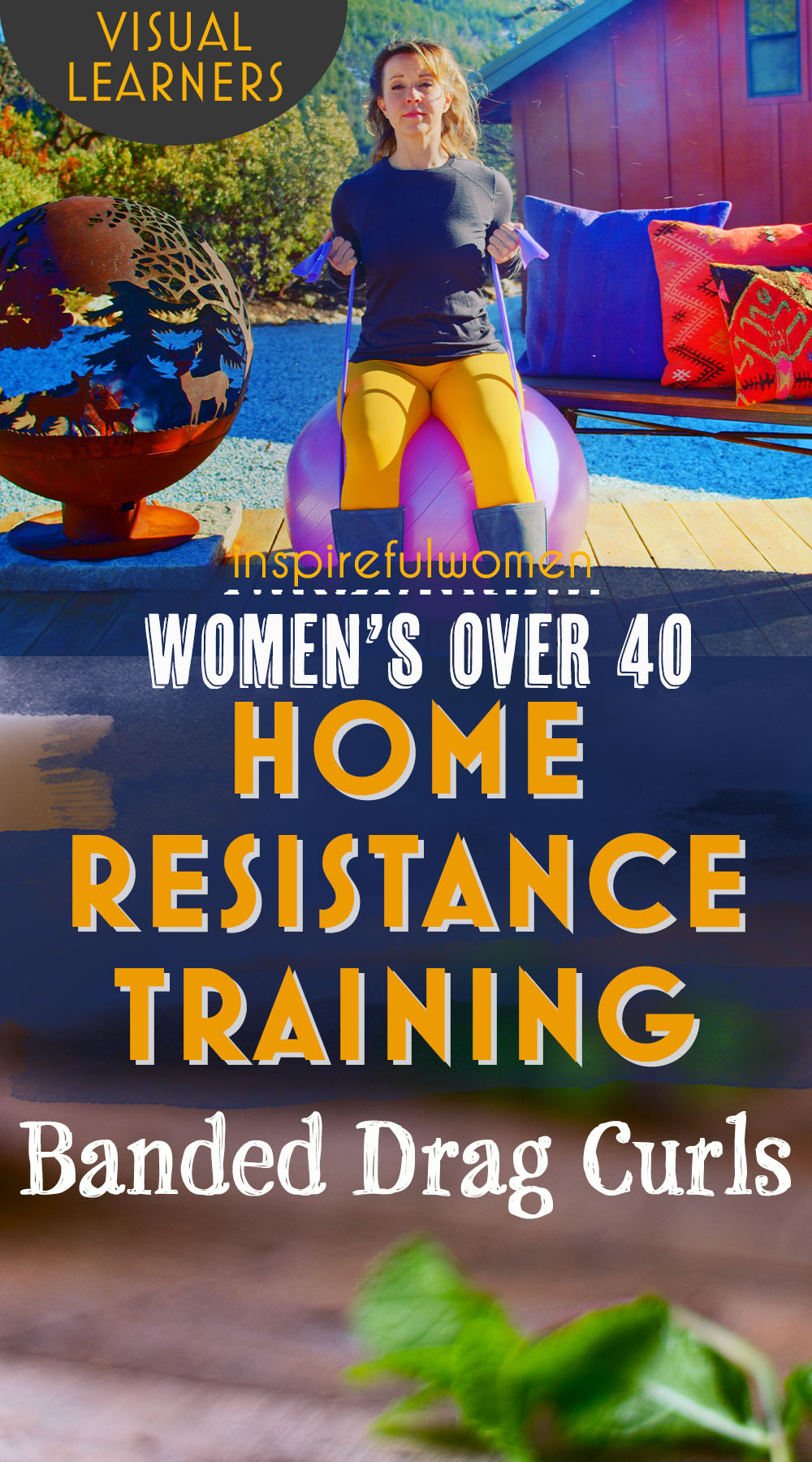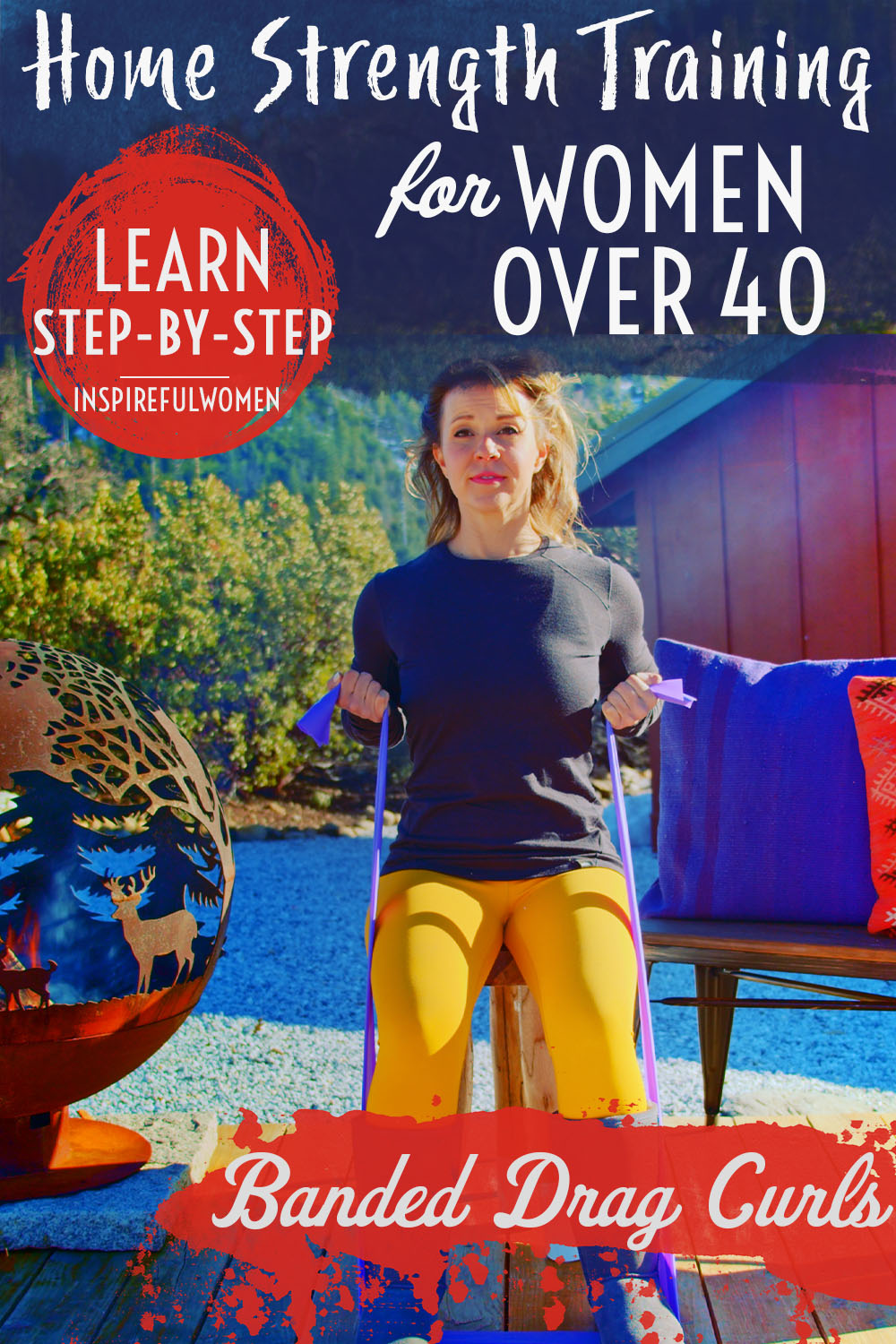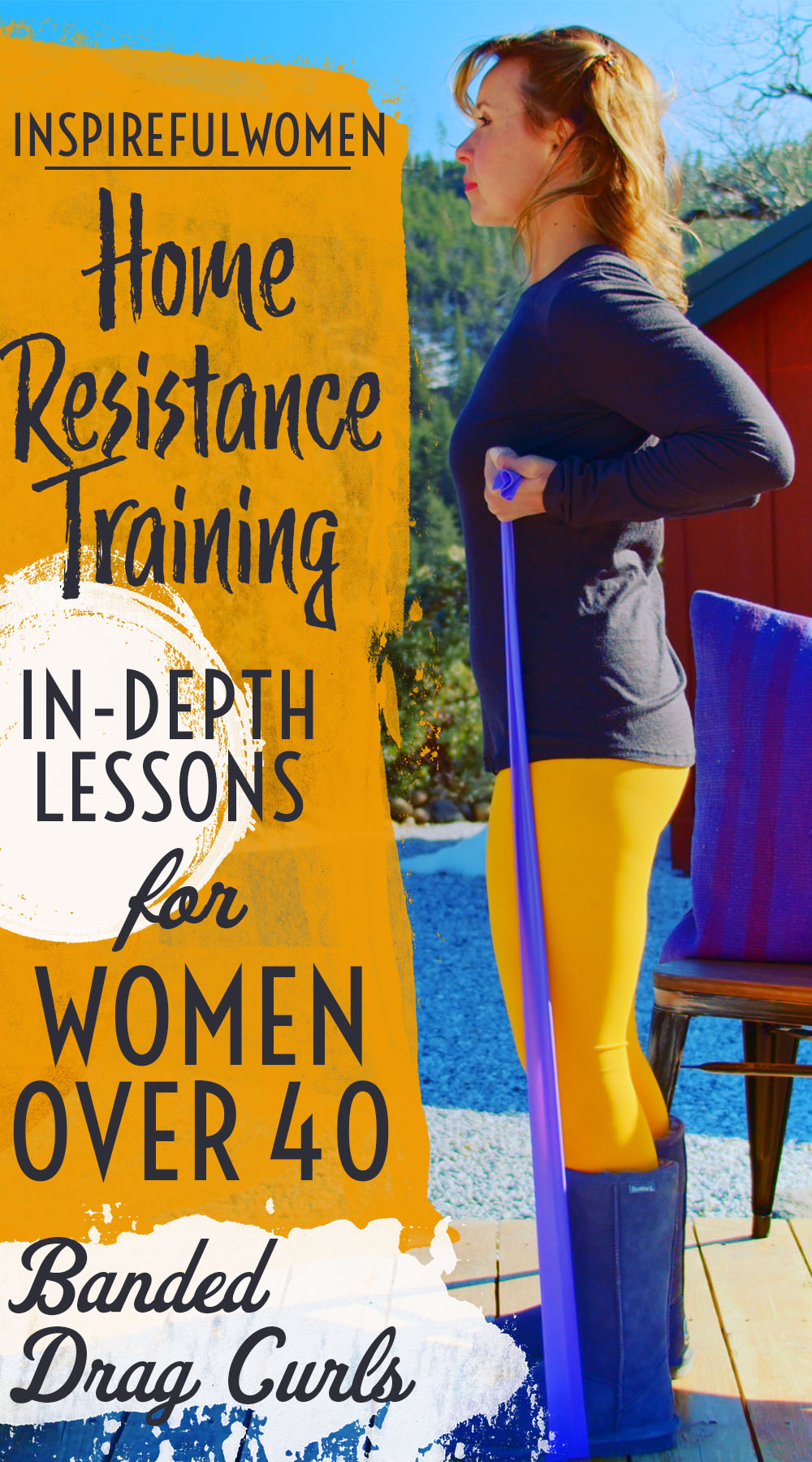Band Drag Curl
How to Do the Band Bicep Drag Curl - Long Head Focus | In-Depth Guide [VISUAL LEARNERS]
Proper Form, Common Mistakes, Variations + Easier & Harder | Home Resistance Training
WHAT DO YOU WANT TO SEE?
QUICK DEMO
QUICK DEMO
MUSCLES THIS WORKS
MUSCLES
MAIN MUSCLES WORKED IN Band Drag Curl
BICEPS BRACHII
OTHER MUSCLES WORKED:
- Multifidi
- Rectus Abdominis
- Erector Spinae
STARTING POINTERS
Starting Pointers
WHAT WE'RE DOING TODAY
Other names for this exercise: Neutral Grip Biceps Curl
ALL WE'RE DOING:
Basically, bend your elbows.
This biceps peak exercise puts the arm in a position that focuses on the long head of the biceps and brachialis. The biceps will be working the hardest at the top of the movement. The weight is pulled up close to the body, this puts less stress on the core and lets you concentrate on using the biceps to lift the weight.
This exercise is thought to increase the “peak” of the biceps - the part that sticks out the most - like the peak of a mountain, by targeting the long head of the biceps and the brachialis muscle.
HOW TO DO THE EXERCISE
LOOKS
HOW Band Drag Curls SHAPE OUR BODY
This unique bicep curl will tone and give you muscle definition in the front of your upper arm (where your bicep is haha!)
It helps give a curvy yet FIRM sculpted look to the arm.
PROPER FORM
PROPER FORM: Band Drag Curls
EQUIPMENT, SETS & REPS
EQUIPMENT
Main set (3: Light/Med/Heavy)
X-Heavy Band (I recommend getting this too if you plan to use resistance bands frequently).
SUGGESTED STARTING WEIGHT FOR WOMEN:
Moderate resistance bands
SETS & REPS:
2 sets of 8 reps
PACE:
Quick up and slower down.
BODY POSITION
BODY POSITION FOR THE Band Drag Curl
BAND: Secure the band under both feet.
FEET: Standing with feet shoulder-width apart, knees slightly bent
BODY STANCE: Neutral spine, shoulder blades in and down your back, sternum lifted.
HAND/GRIP: Palms facing forward (supination) holding one end of the band in each hand. The band enters the hand on the side of the little finger, crossing the palm to the thumb side.
ARM: Shoulders back, not rolled forward. Arms close to your body.
NECK: Neutral and relaxed.
HOW TO DO
HOW TO DO Band Drag Curl
CUE: Keep your arms close to your body and “drag” the weights up the side of your body. Keep your wrists neutral - it is easy to bend them back as you bend your elbows.
Bend your elbows as your upper arm moves back. Your hands will move up along the side of your body. Concentrate on your biceps doing the work, not on your elbow moving back.
Slowly lower your hands back down for the next rep.
HOW TO SAFELY GET OUT OF THE EXERCISE
From the starting position, release the band.
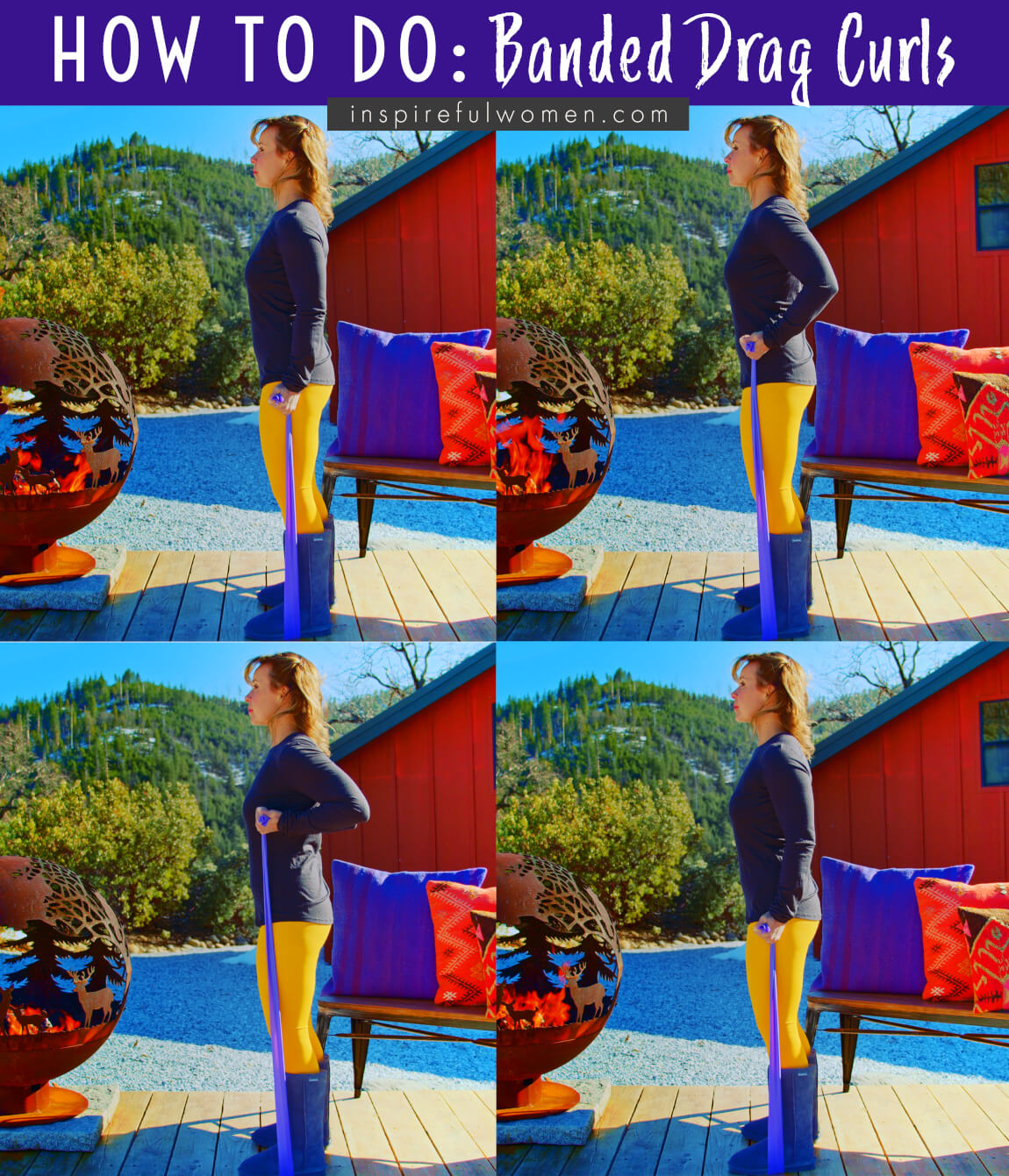
COMMON MISTAKES
COMMON MISTAKES
WHAT TO AVOID WITH THE Band Drag Curl
KEY TIP:
Guess what? Good news! Many avoids are the same for most movements. Once you learn the basics, there's really only a few extra avoids for each individual movement.
1. Avoid Shoulders Hunching Up
AVOID: Avoid hunching the shoulders up towards the ears.
WHY NOT?
- You're just not working the bicep muscles when you do this, that's all. This gets your upper traps (muscles to the sides of your neck where your bra straps usually lay) more involved.
WHAT TO DO:
- You will note decreased space between the shoulders and earlobes.
- Pull the shoulders down to keep the space between the ear and the shoulder during the entire rep - this opens up the shoulder to avoid tendon irritation and decreases the activity of the upper traps.
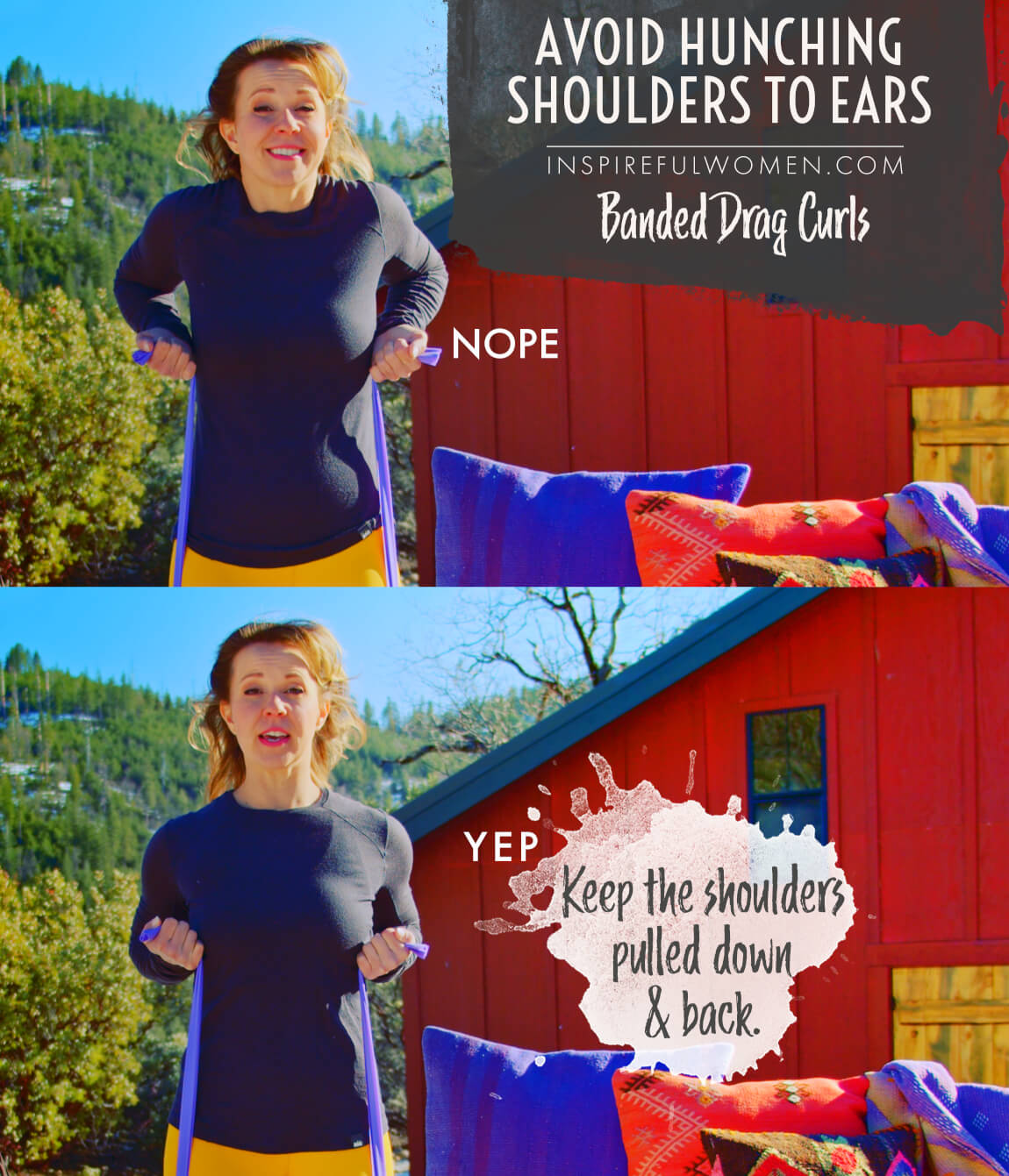
2. Avoid Elbows Flaring Out
AVOID: Avoid letting your elbows move out to the sides.
WHY NOT?
- This will change the downward pull of gravity and will increase the activity of the shoulder.
WHAT TO DO:
- The upper arm should be resting on your sides, not moving.
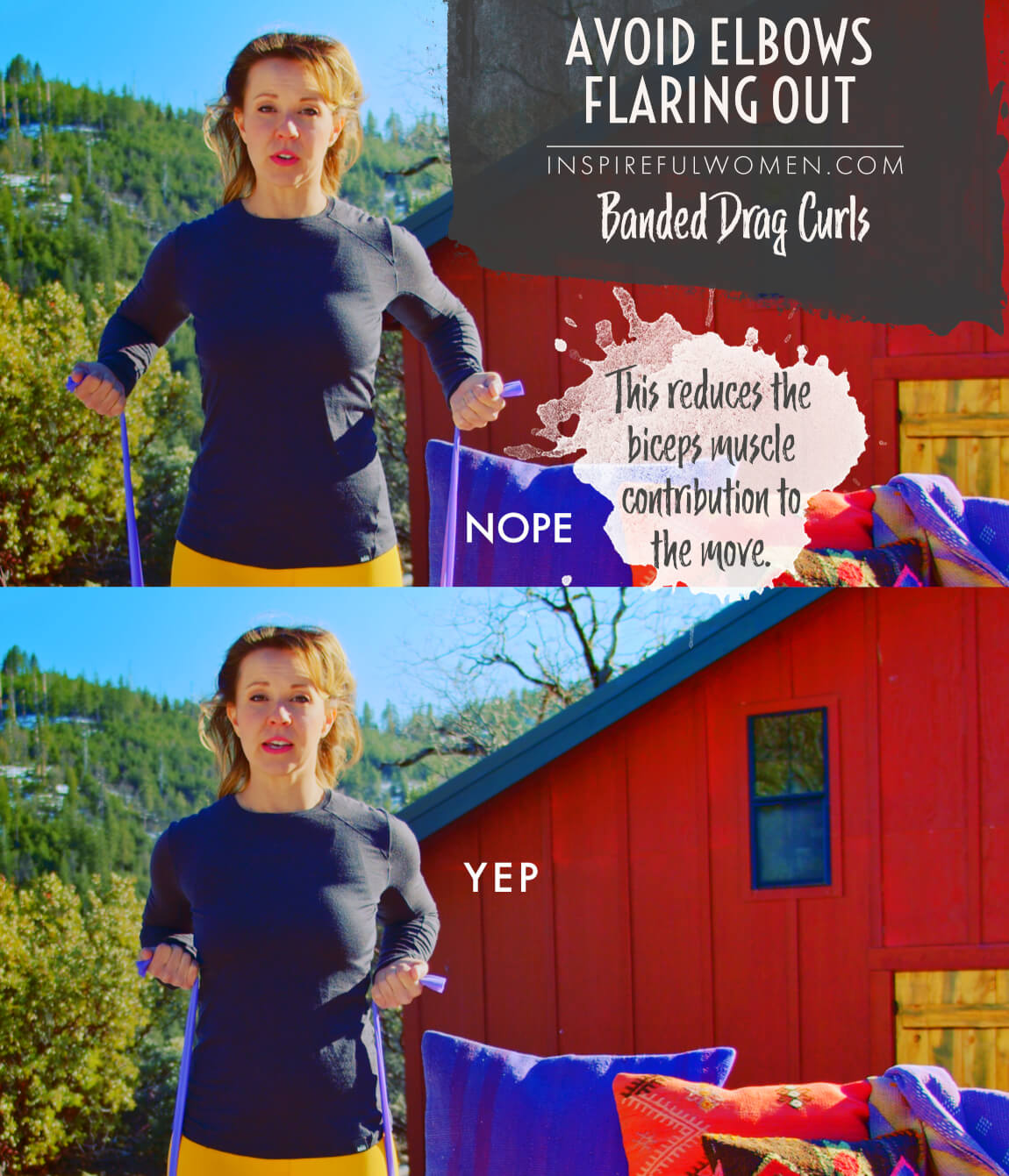
3. Avoid Rounding Shoulders
AVOID: Avoid rounding the shoulders forward.
WHY NOT?
- This means that you are trying to use the anterior deltoid and chest muscles to help bend the elbow.
- This can decrease the space between the shoulder blade and the upper arm bone (humerus) and irritate the tissues.
WHAT TO DO:
- Pull the shoulders blades in and down the back, lift the sternum to correct your posture.
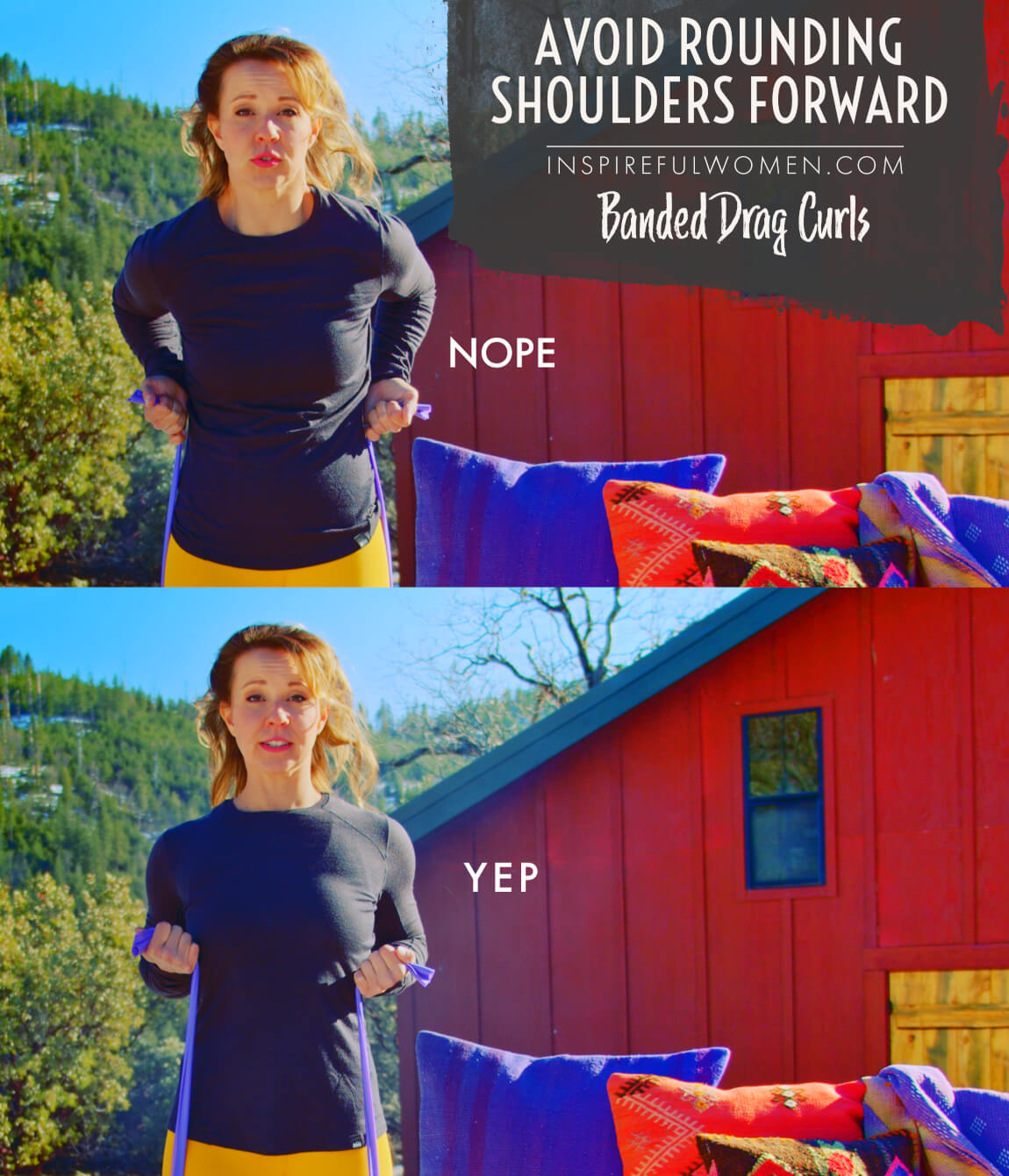
4. Avoid Bending Wrists
AVOID: Avoid bending at your wrists.
WHY NOT?
- Poor alignment (bent forward or backward) or repetitive movement through the wrist can lead to joint and/or soft tissue irritation or injury over time.
WHAT TO DO:
- Your wrists should be in line with your forearm and should be still throughout the exercise.

VARIATIONS
VARIATIONS
VARIATIONS OF Band Drag Curls
Single-arm
One-Arm Band Drag Curl
This helps you train both arms equally. Holding the non working arm in the starting position (elbow straight) will let the muscles relax before exercising it; Optionally: hold the arm at the end range of the movement - elbow bent with forearm parallel to the floor - this will keep the muscles of the “non-working” arm under tension as the other arm completes its reps.
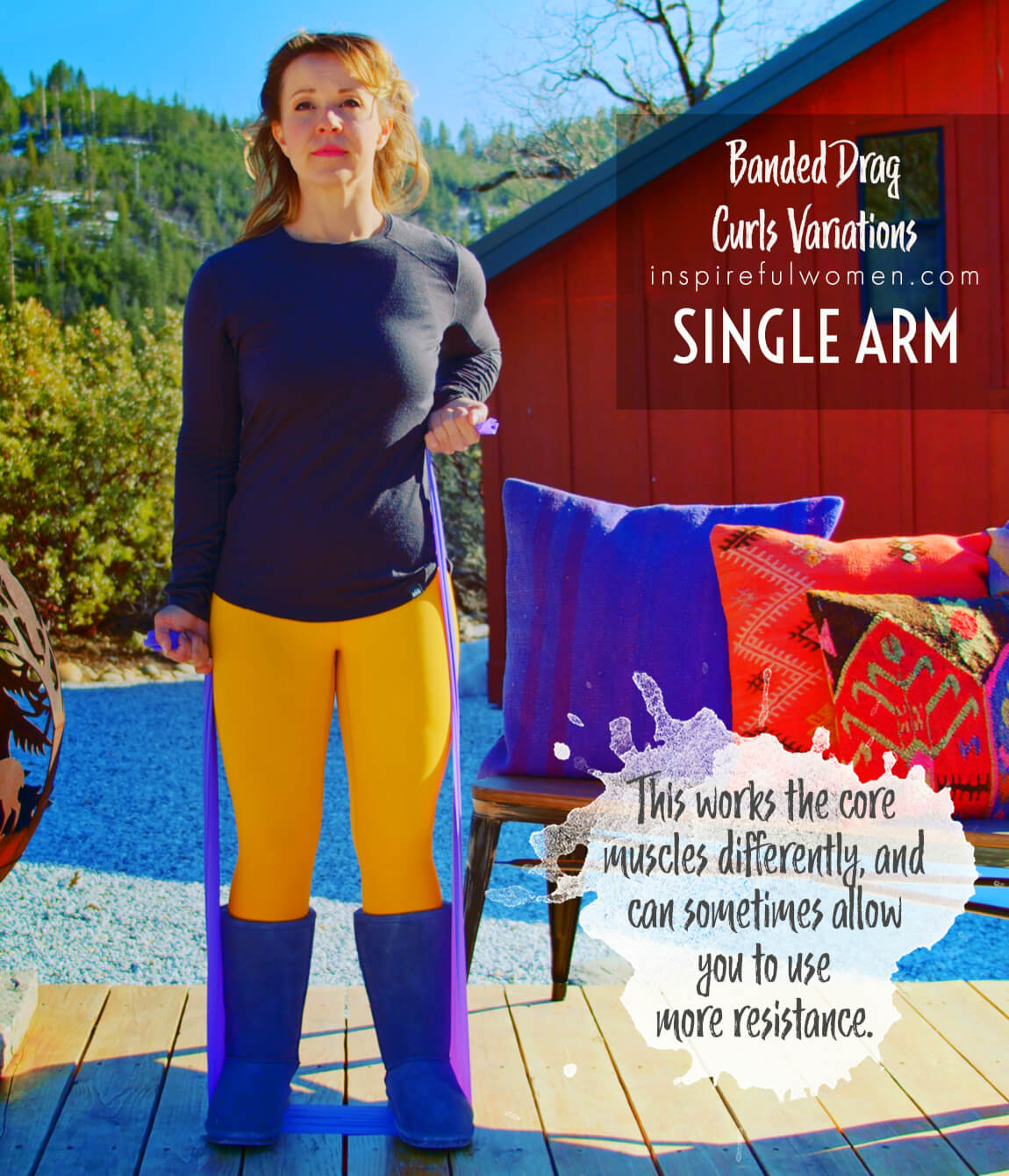
alternating
alternating band drag curl
Work one arm at a time, alternating left and right. This will work the core muscles differently - the obliques and quadratus lumborum will be more active to stabilize against the uneven left and right loading. There are two options: 1) complete one rep on the right and then one rep on the left - this will allow each arm a short rest between reps, it will also put less demand on the core muscles so you may be able to use more resistance. 2) Bend one elbow, hold the bent elbow position, bend the other elbow and hold. Straighten the first arm, and then the second arm to complete the one rep. This will keep the biceps under tension for a longer period of time.

add shoulder flexion
drag Curl plus shoulder flexion
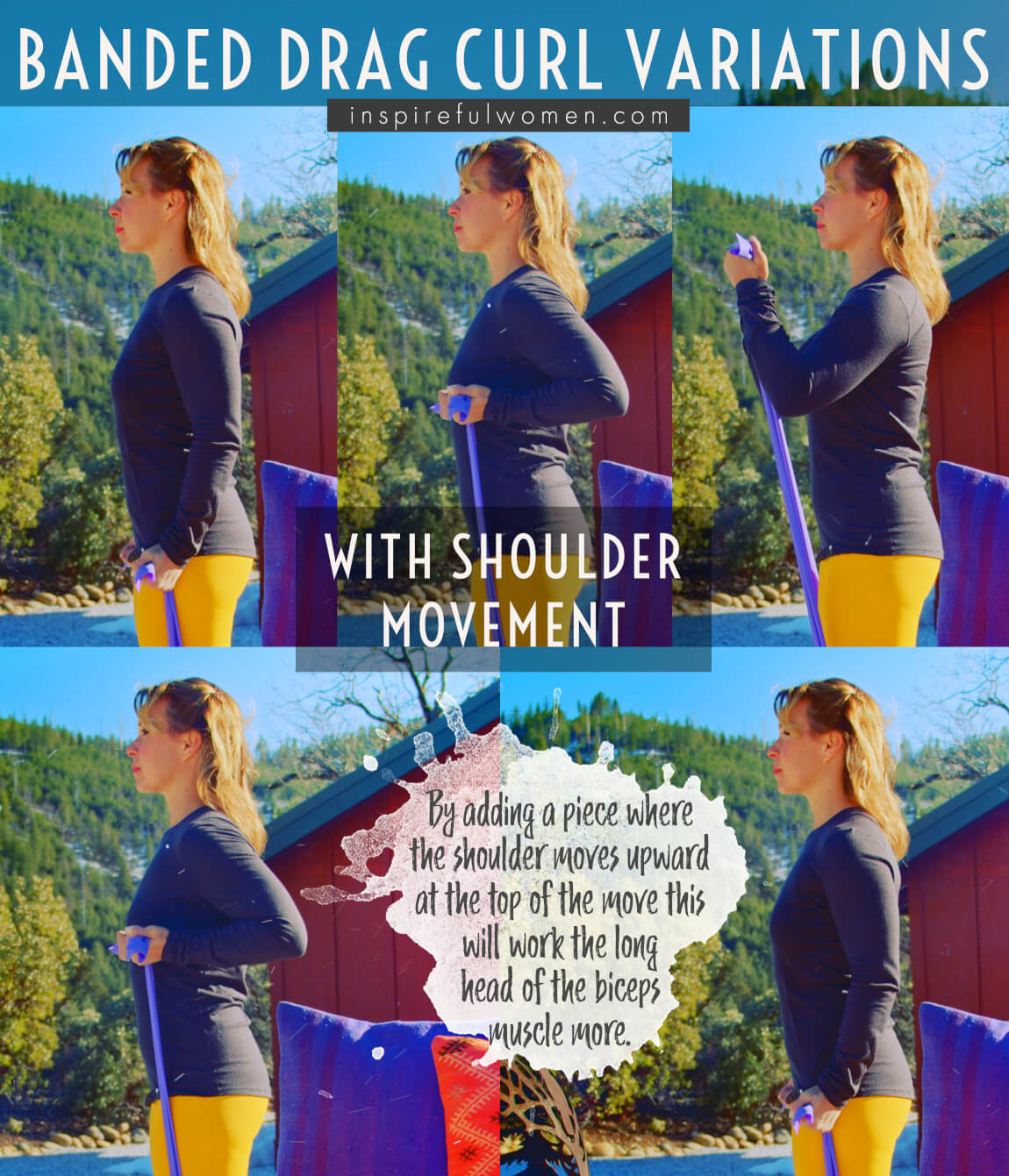
MAKE IT HARDER
HARDER
MAKING THE Band Drag Curl MORE CHALLENGING
Pulses
pulsing band Bicep drag curl
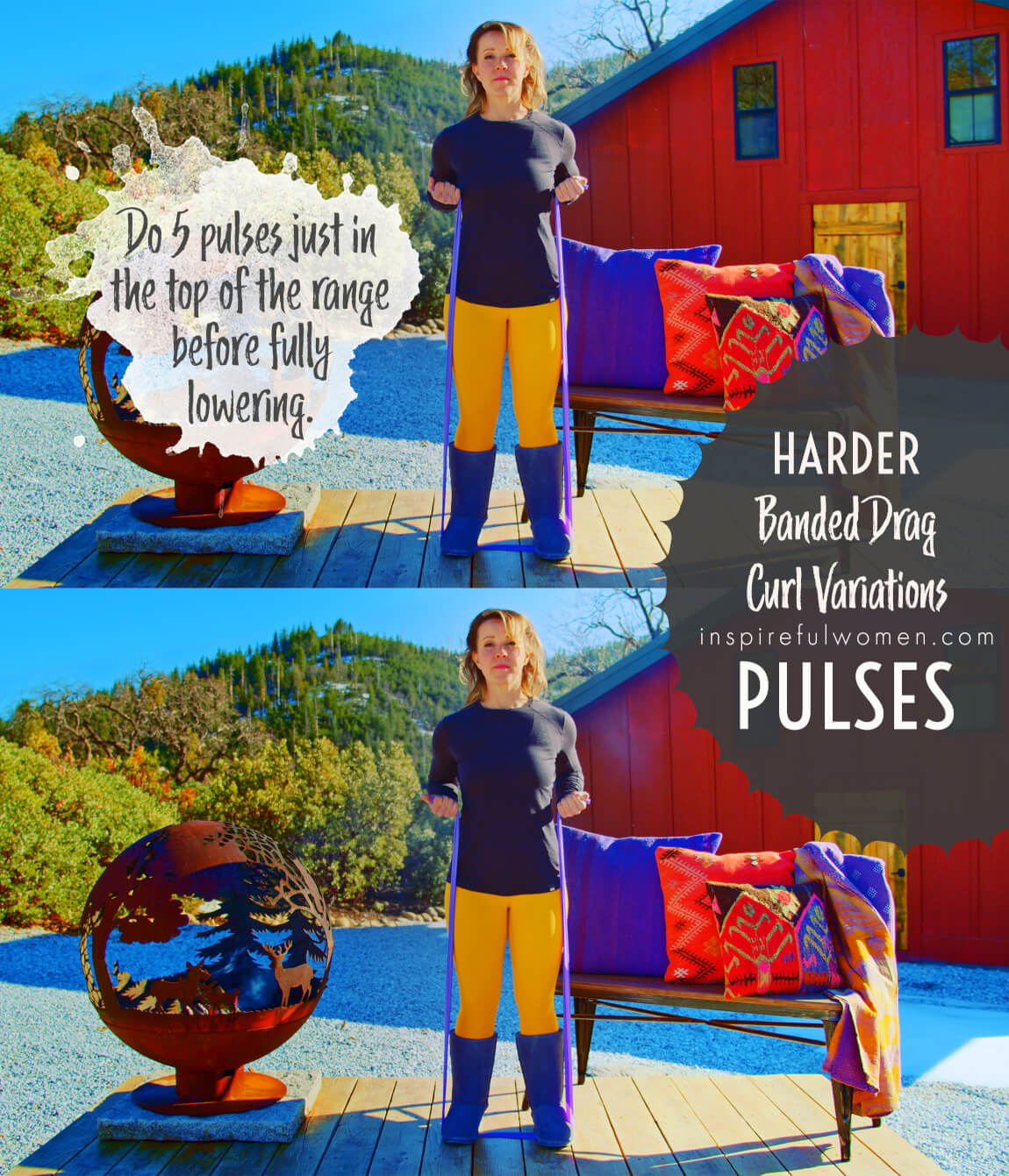
MAKE IT EASIER
EASIER
MAKE THE Band Drag Curl MORE DOABLE
SEATED ON STABILITY BALL
Stability ball drag curl
Sit up tall on a stability ball, without leaning back. Neutral spine. The feet flat on the floor, shoulder width apart. Anchor the band under both feet. Your arms can be slightly forward to clear the ball and to reach the band. Moving the feet closer together will be slightly more difficult and further apart will be easier. This variation is less stable than sitting on a chair but more stable than standing. The core muscles and leg muscles will not be as active. This is a good position for those who have problems with balance, leg or core strength, and for first learning the movement.

Seated
Seated Band drag Curl
Use a chair without arms or a bench. Sit up tall without leaning back, sit close to the edge of the seat. Neutral spine. The feet are flat on the floor, shoulder-width apart. Anchor the band under both feet. Your arms can be slightly forward to clear the chair and to reach the band. Moving the feet closer together will be slightly more difficult and further apart will be easier.
This movement is done in a very stable position, the core muscles and leg muscles will not be as active. This is a good position for those who have problems with balance, leg or core strength, and for first learning the movement.
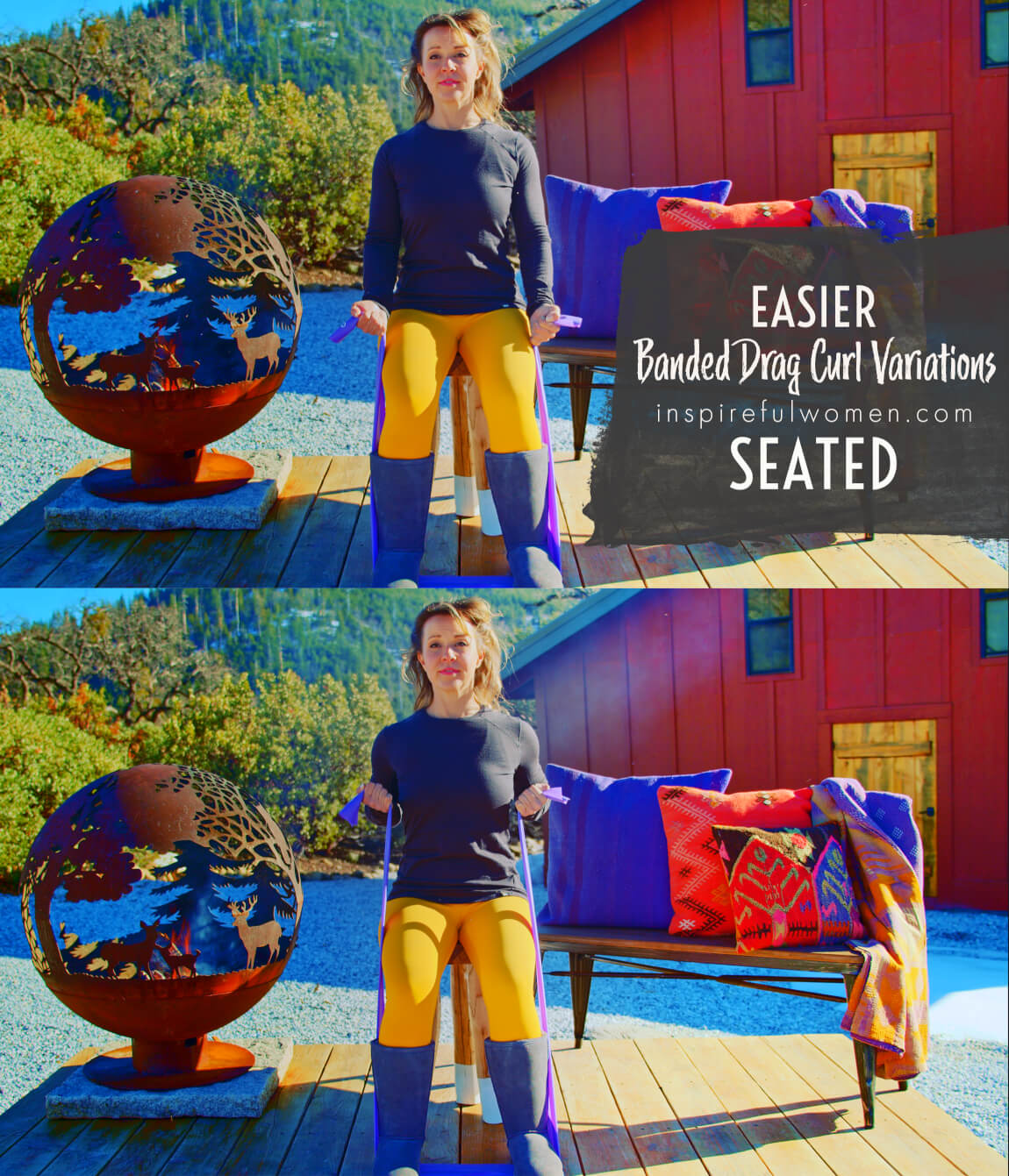
WHAT WE'RE DOING TODAY
WHAT & WHY
BENEFITS OF TRAINING THE biceps
WHAT
The biceps brachii (bicep means that the muscle has two heads connecting at different places, and brachii - meaning arm) is the big muscle lying on the upper part of the front of the arm - between the elbow and the shoulder. This is probably the most well-known muscle of the arm - sometimes referred to as the beach muscle. The main function of the biceps brachii (not to be confused with the biceps femoris which is one of the hamstring muscles) is to bend (flex) the elbow, moving the hand closer to the body.
The biceps brachii also can rotate the forearm so that the palm is facing up. The rotation of the forearm is due to one of two long bones in the forearm rotating across the other. This is called supination.
Most of the exercises for the biceps muscle most effectively are movements that combine bending (flexing) the elbow with rotating the forearm to a palm-up position (supination). The bicep is a big, powerful muscle. Exercises that target this muscle can usually be done with quite a bit of resistance.
WHY BOTHER DOING IT?
WHY
WHY DO WE EVEN CARE?
Crossfitting for 8 years we never did specific bicep work, and most of the movements didn’t really work your biceps much. Once I started doing bicep curls regularly, I noticed a big difference. One day I needed to carry a 5-gallon bucket of stuff in each hand for quite a long distance. I was amazed at how much easier it felt than a while back! That’s from the biceps being stronger. This is also helpful for holding other things in your arms - a stack of books, children, getting all the groceries into the house in one trip, pulling heavy pans full of turkey and potatoes out of the oven, carrying a load of firewood, or a stack of lumber.
The biceps brachii crosses the shoulder joint, so it is able to lift the arm up (shoulder flexion). Since it crosses both the elbow and the shoulder it plays a role in stabilizing those joints. The job of the arm is to move the hand to where it needs to be, and then to hold the arm still as the hand does what it needs to do. The biceps is extremely important for both moving the arm through an endless number of positions and holding it still. Strong biceps will make everyday life activities easier and will improve the health of your elbows and shoulders.
EVERYDAY LIFE
EVERYDAY LIFE &
MUSCLE FUNCTION
HOW WE USE OUR biceps MUSCLES IN EVERYDAY LIFE
1. BENDING THE ELBOW (ELBOW FLEXION)
- Eating
- Lifting glass for drinking
- Dressing
- Lifting
- Carrying
- Washing/brushing hair
- Stirring
- Painting
- Brushing your teeth
- Weeding
- The list is pretty much endless...
2. TURNING YOUR FOREARM UP (SUPINATION)
- Turning a doorknob
- Using a screwdriver
- Turning a key
- Turning a spigot
- Receiving change
- Carrying a plate
3. LIFTING THE ARM (SHOULDER FLEXION)
- Reaching up
- Dressing
- Pushing a window up
- Washing windows
- Lifting up to the front - kids, boxes
- Carrying in front: kids, groceries, books
4. STABILIZING THE ELBOW AND SHOULDER
- Writing
- Knitting
- Reading a book
- Using a screwdriver
- Holding items in front of you - carrying a heavy box, pushing a wheelbarrow
HOW TO FEEL WHAT MUSCLE IS WORKING
How to Feel What Muscle is Working
Bend your elbow. Place the other hand on the upper arm with the bent elbow. Lift a heavy object with the arm - you will feel the biceps contract under your hand.
SCIENCY STUFF
ALLLL MUSCLES & WHEN
ALL MUSCLES WORKING & WHEN DURING THE Band Drag Curl
As the elbow bends the biceps, brachioradialis (crosses the elbow joint and flexes the elbow) and brachialis (flexes the elbow) work concentrically to flex (bend) the elbow. The biceps brachii and the supinator (muscle that turns/rotates the forearm from hairless-side down to facing up) muscle work to hold the forearm in supination. The degree of contribution from the brachioradialis muscle will vary depending on the speed of the movement and load – it is used to add speed or power to elbow flexion. The biceps brachii is strongest between 80 and 100 degrees of elbow flexion (where 90 degrees would be your forearm parallel with the floor- so 10 degrees below and above that is the range), and the brachialis is strongest at 100 degrees of elbow flexion. The triceps co-contract in the beginning of the movement to stabilize the elbow joint and work to extend the shoulder as the elbow bends – although this contribution should be minimal.
The scapular stabilizers, the small muscles that keep the shoulder blade in position, deltoids and rotator cuff will work throughout the exercise for upright posture and to stabilize the shoulder joint. As the elbow extends the same muscles of the arm work eccentrically to return to the starting position.
PIN IT FOR LATER!
